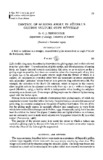| dc.description.abstract | 1. The drag of the frozen, wingless body of a Rüppell's griffon vulture was measured in a wind tunnel with a simple drag balance. The drag coefficient with feet and neck retracted was 0.43, based on the greatest cross-sectional area of the body.
2. The drag of the body was trebled by fully lowering the feet, and more than quadrupled when the tail was lowered as well, apparently owing to separation of the flow over the back. The drag coefficient of the legs and feet, based on their frontal area, varied from 0.89 to 1.08 in different positions.
3. At low speeds the use of the feet alone should reduce the glide ratio from about 15 to 10, but the airbrake effect becomes progressively more marked at higher speeds. At lower speeds reduction of the wing area produces a greater steepening of the gliding angle, but at the expense of increasing the minimum speed. Increase of induced drag would provide a highly effective gliding angle control at very low speeds, and it is suggested that this is achieved by raising the secondary feathers, which would alter the spanwise lift distribution by transferring a greater proportion of the lift to the primaries. | en_US |

